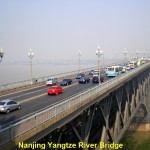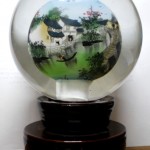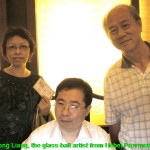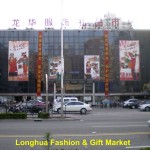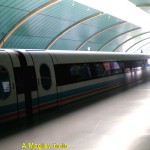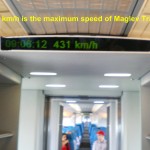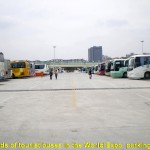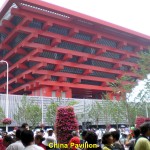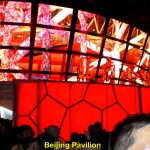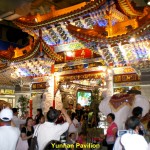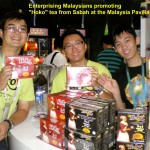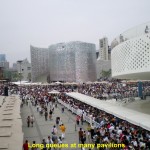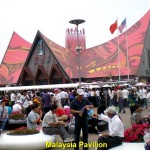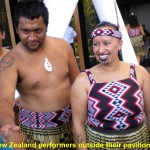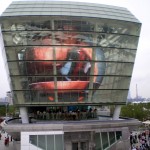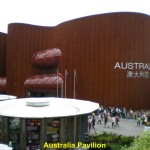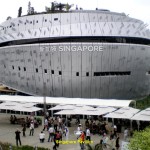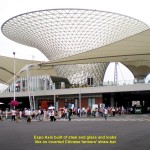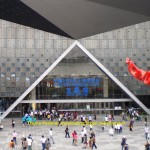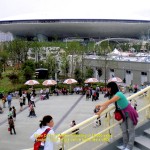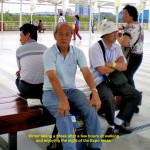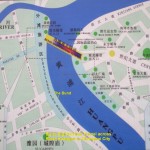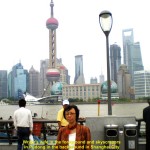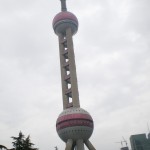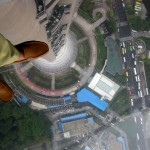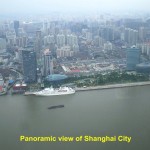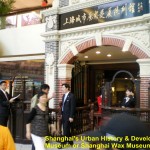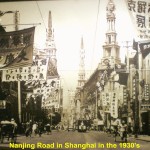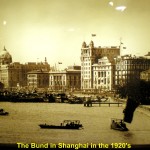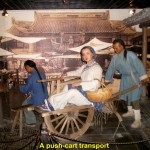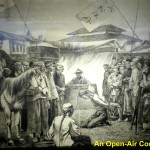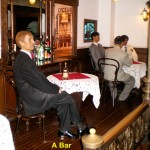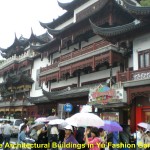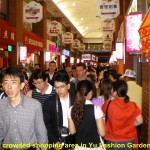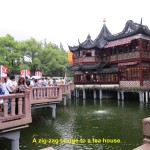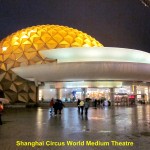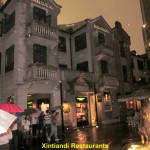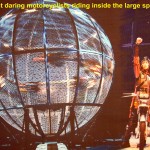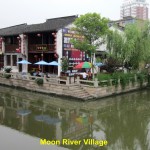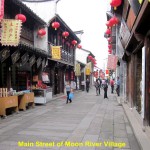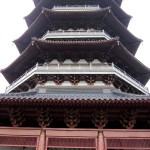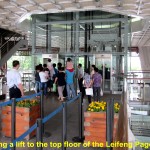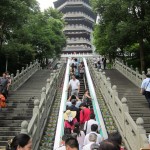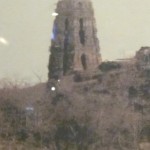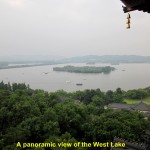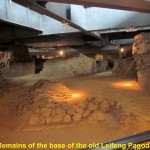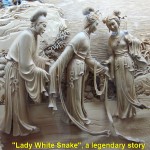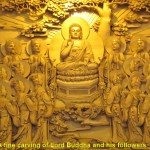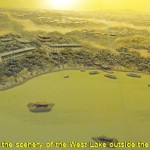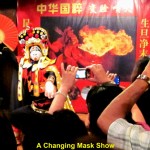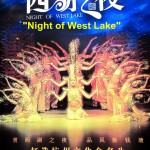Shanghai Travel II
(continued from Shanghai Travel I)
Shanghai Travel II
(Nanjing Bridge, Shanghai Expo 2010, Shanghai City)
Day 5 7 June 2010 (Monday)
In the morning, the first thing our Nanjing tour guide, Mr. Lee, wanted us to see was the China’s historic bridge, known as “Nanjing Yangtze River Bridge”.
Nanjing Yangtze River Bridge
It is a massive double-decker steel bridge with a highway on top and railway track below. Built in 1968 over the China’s second longest river, Yangtze River is 4,589 metres long. The Chinese are very proud of this bridge as it was built without any foreign assistance.
When we arrived at the bridge we took a lift to the top of a building that is beside it and watched a constant flow of vehicles on the upper deck of the bridge and, once, a train moving on the track below it. We also saw the scenery of the river, but it was spoiled by some mist in the area then.
Glass-Ball Paintings
Then we went down to a shop on the ground floor of the building to see unusual artworks: paintings inside glass balls. In the shop, glass-balls of different sizes with different Chinese paintings were displayed on shelves. They were mostly for sale, but they did not come cheap. Most of the paintings were done by a famous artist named Gong Liang and the rest by his students. We were told by our Nanjing tour guide, Mr. Lee, that the artist was very generous as he would donate most of his sale proceeds for the repair and maintenance of the grand bridge, the Nanjing Yangtze River Bridge. When my wife bought one of his art pieces, both of us had the honour of taking a photo with him. Unfortunately, the photo turned out to be dark, as we were told to take the photograph without flash that might damage the artist’s valuable eyes. Anyway, with digital technology, the photo is edited and can be seen clearly as shown here.
Shanghai City
At 2.30 p.m. we left the bridge and began a long journey to China’s largest city, Shanghai. It would take us four hours to reach the metropolitan.
Shanghai has a population of about 20 millions. Located at the estuary of Yangtze River, it was founded by the Song Dynasty(969-1279 A.D.) and became a thriving trading port in the 17th. Century. It has a colourful history, and rich eastern and western cultures. Now, it is the largest financial, commercial, trading and tourist centre in China.
Longhua Fashion & Gift Market, Shanghai
When we arrived at the vibrant city of Shanghai, the first place we visited was an old shopping mall known as Longhua Fashion Gift Market. At the entrance of the mall, we were surprised to read a government notice which warned shopkeepers not to sell fake goods with branded names. When we went round the mall we were surprised that none of the goods had branded names. The good shopkeepers had abided with the request in the notice.
As it was Monday when we visited the mall, there were very few visitors and many shops were closed. After spending less than an hour there, we left for dinner at a restaurant and then we checked in at a hotel known as Shanghai Airlines Travel Hotel.
Day 6 8 June 2010 (Tuesday)
Shanghai Maglev Train
In the morning, we went to Shanghai Pudung International Airport to have a high speed experience on a Shanghai Maglev Train. It is the only magnetic levitation train in China. In 2004, it began its operation running a distance of 30.5 km in about 8 minutes from the airport to Lonyang Road Station in the outskirt of Shanghai City. Its top speed is 431 km/h. We enjoyed the ride as it was smooth, fast and quiet; unlike the conventional train which is noisy, jumpy, jerky and slow. In future, China is going to build long distance tracks for Maglev trains linking all its major cities.
World Expo 2010, Shanghai City
At 12 noon, we went to a Huangpu River waterfront near the Lupu Bridge in Shanghai to see the World Expo 2010 which commenced on the 1stof May and will end on 31st. October 2010. Held with the theme “Better City, Better Life”, it is the largest exhibition in the world with over two hundred foreign participants and expects a total of 70 million visitors.
On arrival at the Expo site, we were surprised to see hundreds of tourist buses parked, neatly, in a large open space. We were delighted that we did not have to queue up for a long time to enter the Expo site as it was already 12.30 in the afternoon.
China Pavilion
While we were in the Expo area, we were amazed to see lots of visitors everywhere. Our chief tour guide, Mr. Chu, told us that the average daily number of visitors at the Expo is about 300,000. He led us to the China Pavilion. It was a long walk to the large, red building which looks like an inverted pyramid.
As we were walking to the building, Mr. Chu told us that the tickets for the exhibition in the main hall of the China Pavilion were already sold out a few months ago, but he asked us to join a very long zigzag queue to another hall adjacent to the main one. The admission for that exhibition was free.
Mini-Pavilions
After more than 30 minutes of queuing up, we, finally, entered the hall. It was a very large hall where there were many mini-pavilions close to each other. Each mini-pavilion was represented by a province of China boasting of its rich histories, cultures, ethnic peoples, economies, scenic landscapes, etc. Owing to time constraint, we made a quick tour of all the mini-pavilions. When we came out of the hall, we felt as though we had visited all the provinces in China.
Long Queues
While we were outside the China Pavilion we were shocked to hear announcements after announcements that the queuing time at Japan’s Pavilion was then 5 hours, Italy’s 3 hours, Germany’s 2 hours, USA’s 3 hours, and so on. That discouraged my wife
and I from going near those pavilions. So, we walked along a long elevated walkway that cut across the Expo site in the middle and felt contented looking at the pavilions of different shapes and sizes; some were nearby while others far away.
Malaysia Pavilion
Then in the late afternoon, we decided to visit our own country’s pavilion, Malaysia Pavilion. Fortunately, the queue was short when we arrived there. As the queue was moving slowly, we were occasionally pushed roughly by impatient visitors behind us and a few uncivil ones jumped queue. After 23 minutes of lining up, we, happily, entered the pavilion. There were quite a lot of exhibits inside that showed some Malaysian places of interest, racial, religious and cultural diversities, a variety of economies, arts and crafts, etc. We were glad that our Malaysian pavilion had put up an impressive exhibition.
Visiting Other Pavilions
Then we went to look for pavilions that had short queues. We managed to enter three more pavilions belonging to Brunei, Cambodia and New Zealand without much waiting. By the time we visited the last one, it was time to leave the Expo site. While leaving the place, we felt disappointed for not being to visit the popular ones such as Japan, USA, Italy, and Britain.
When the World Expo 2010 in Shanghai is over, it is sad that all the pavilions costing tens of millions of dollars each, except the China Pavilion, Expo Axis, Expo Culture Centre, Expo Centre and Theme Pavilion., will be torn down.
A Lost Tour Member
At 7 p.m. we went back to our bus outside the Expo site. But we could not go for dinner, immediately, in the downtown as one of our tour members did not turn up yet. Our chief tour guide, Mr.. Chu, and tour group leader, Miss Ng, walked back to the Expo site and searched for him, frantically. An hour later, we all heaved a sigh of relief when we were told that he was found waiting at the wrong place. When he came back and joined us on the bus, he apologized to us, profusely, for causing the delay.
Golden Jaguar Plaza Restaurant
For the late dinner, we went to a large restaurant, Golden Jaguar Plaza Restaurant, and had a buffet-style dinner. It provided over 200 kinds of food and we, happily, savored many of them. After that sumptuous meal, we went back to our hotel and slept like a log.
Day 7 9 June 2010 (Wednesday)
After breakfast, we visited a Chinese medical shop selling Baoshutang medicines which it claimed to have remedies for many body ailments, including eczemas(skin problems), arthritis, sprain, muscular ache, insect-bites and rheumatism. Then, we went to the most popular tourist spot in Shanghai City, The Bund.
The Bund, Shanghai City
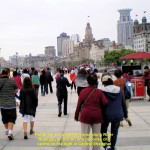
The Bund is a waterfront between River Huangpu on the left and historic city centre in Puxi on the right
The Bund, in the city centre, is a stretch of embanked waterfront along the Huangpu River. At this place, a visitor can see a row of grand, old colonial buildings along Zhongshan Road(E-1) and skyscrapers of modern architecture in the financial centre, Lujiazui, across the Huangpu River. We spent an hour enjoying the breathtaking sceneries and the refreshing air from the sea at the Bund. Then we left the place and went underground to take a small cable car which passes through a tunnel under the Huangpu River to the other side of the river. The tunnel known as the Bund Tourist Tunnel is 647 metres long and was opened in 2000.
The Oriental Pearl Tower
Having reached the other side of the river in a few minutes, we went straight to Shanghai’s iconic landmark, the Oriental Pearl Tower. Standing 468 metres high at the crossroads of Fenghe Road and Lujiazui Road, it is the highest TV tower in Asia and 3rd. in the world. It is a tourist attraction and allows tourists to go up as high as 350 metres to get a spectacular 360 degree-view of the Shanghai City.
When we went up the tower the first place we went to was the revolving restaurant at the height of 267 metres. As we were having lunch at the restaurant, we could see the outside scenery that, seemingly, moved and felt as though we were on top of the world. After the meal, we went down to the lower floor which was 259 metres high. Standing on the circular floor which was made of glass, we could see part of the city just below our feet and also other parts through a glass-wall surrounding the floor; everything down there seemed small, like toys.
It was an unforgettable experience to view the city from such a height. As we were walking on the circular glass-floor that had a circumference of 159 metres we noticed that some tourists were afraid to step on it while others were very excited asking their friends to take their photos.
Shanghai’s Urban History and Development Museum or Wax Museum
After that exciting height experience we went down to the ground floor and entered a museum that is known as Shanghai’s Urban History and Development Museum or commonly known as the Shanghai’s Wax Museum. It has over 1,000 exhibits, including 100 live-like wax figures, related to the past history and development of the urban Shanghai. In the museum, we visited five halls of different themes, like the old city transportation, the old city scenes of economic activities, the city’s architectural landscapes in the 20th. Century, the activities of foreigners who lived in the city, the city lives of the Chinese, etc. It took me quite awhile to learn a lot about the interesting past history of Shanghai City in the museum.
Yu Fashion Garden(Yuyuan Market)
Next, we went to a famous large shopping area known as Chenghuangmiao Shopping Centre, City God Temple Shopping Centre, Yu Fashion Garden or, commonly, known as Yuyuan Market in the old city of Shanghai. It was believed that a temple was built in this area for the local people to worship a god whom they thought could protect and gave them good harvests, annually. As there were lots of worshippers going to the temple, especially, on festive days, many shops were built near it to cater for their needs. Recently, all those old shops were torn down and new, large, beautiful ones that look like an ancient Chinese temple were built. The old temple was also rebuilt for the worshippers.
This place, Yuyuan Market, is now a popular tourist shopping centre where shops sell all kinds of merchandise, ranging from food and beverages to bags, clothes, electrical goods and jewellery. While we were there busy shopping and admiring the architectural structures of the buildings, it was raining. But the rain did not deter more tourists from going to the place.
Shanghai Circus World
In the evening, after dinner, we went to the Shanghai Circus World to watch a show called “ERA: Intersection of Time“. This show amazed us as the young, energetic performers did a lot of brave stunts that kept us excited but nervous , sometimes. The most daring stunt that kept us on edge all the time was the grand finale of the show: a motorcycle stunt. In the stunt, motorcyclists rode their machines round and round inside a large sphere made of metal strips. At first, a motorcycle entered the sphere and went round and round inside, then followed by another, later, another, then another, and finally a total of 8 motorcycles moving in two separate circles inside, continuously. That was an extreme spectacle and everybody applauded loudly. When the stunt ended, all the motorcyclists came out of the sphere, one at a time, and stopped in the centre of the ring. When they took off their crash-helmets we were surprised to see two of them who were ladies.
Xintiandi
After that exciting show, we went to an interesting place known as Xintiandi (or “New Heaven and Earth”). It is a place where small, quaint colonial buildings with narrow walkways, offer merchandise, food, beverages and entertainment which are a bit pricey. It is a romantic place in the evening as the place is dimly-lit. Because of its mixed setting of Chinese and European in an old place, it attracts many tourists. We spent a short time there as it was raining. Then we left the place for our hotel.
Day 8 10 June Thursday 2010 (Thursday)
Moon River Town, Jiaxing
This was the last day of our tour. In the morning, we left Shanghai City for Hangzhou City which is a few hours away by bus. On the way, we stopped at an old water town which is a tourist attraction in Jiaxing. Known as Moon River Town, it has canals and rivers along which ancient houses have been built, like the old water town we have visited in Suzhou City. Its narrow roads and walkways are built of large bricks. Most of these buildings are shops that sell souvenirs, antiques, medicines, food, drinks, clothes, flowers, arts and crafts. We had our lunch in a restaurant there.
Leifeng Pagoda in the Evening Glow
Later, we left the Moon River Town and continued our journey to Hangzhou City. Before reaching the city, we stopped at another place known as Tongxiang Tongxin Food Co., Ltd. in Tongxiang City where we bought some young dry chrysanthemum flowers which the producer claimed had health benefits. Then we moved on and finally reached the city in the late afternoon. On arrival we went to our last place of interest. It is a well-known pagoda called Leifeng Pagoda in the Evening Glow.
Erection of the Pagoda
Originally, a pagoda was built on a small hill, Sunset Hill, which is in the south of the West Lake, in 977 A.D. to keep the Lord Buddha’s hair coated with silver and gold. According to another version, the pagoda was erected by Qian Hongchu, who was the king of the Kingdom of Wu and Yue, to celebrate the birth of his son by his favourite concubine named Huang.
It had been damaged, repaired, burnt down and rebuilt many times. In 1924 it collapsed due to a long period of neglect. Then in 2002, a new, beautiful, magnificent and elegant pagoda was built on the original site. It is five storeys high (about 72 metres), octagonal in shape and built mostly of steel and copper. It has two lifts in the middle that bring visitors to the top four levels for viewing the scenic West Lake and the mountainous areas.
Inside the Pagoda
On the ground floor of the pagoda, visitors can still see the remains of the base of the old pagoda. At other levels above, there are paintings and carvings depicting the life of Lord Buddha and the legend about the immortal Lady White Snake, and the writings and paintings about the old pagoda and an emperor‘s visit to the pagoda. Besides, at one level, there are three-dimensional pictures of the West Lake sceneries a visitor may see outside the pagoda if he is on a viewing deck.
In the evening when the sun is setting, the shadow of the pagoda together with the colours of the sky in the reflection at the lake make the pagoda seem to be glowing, thus it is known as Leifeng Pagoda in the Evening Glow.
Leifeng Pagoda Visit
When we arrived at the foot of the Sunset Hill, we saw lots of visitors going up the hill to the pagoda by elevators instead of climbing up the steps. Then we followed them and reached the base of the Leifeng Pagoda. Standing right in front of the pagoda and looking up, we were astounded to see the large, towering pagoda. When we entered the pagoda, we saw the remains of the old pagoda base. Later, we went up by lift to all the levels to see the paintings and carvings on the wall, and the panoramic views of the scenic West Lake, Hangzhou City and the mountainous areas which were spectacular.
Ba Gua Bu Yi Cuisine Restaurant, Hangzhou City
Then we left the pagoda to have dinner in a restaurant known as Ba Gua Bu Yi Cuisine Restaurant in the Hangzhou City. When we had finished the meal we were entertained by a big man in a heavy Chinese traditional costume. He was wearing many masks. As a Chinese song was played, loudly, he danced on a small stage and changed his masks one at a time fast. He was an amazing performer, as he could change more than ten different masks in one song.
“Night of West Lake“ Show
After enjoying the one-man show, we left for a theatre, Dongbo Theatre, to watch a splendid and spectacular Chinese cultural show known as “Night of West Lake“. It was an extravaganza that had five parts: “King Yue’s Power”, “Prosperity of Qiantang”, “Butterfly Lovers”, “Elegance of Qiantang”, and “Oriental Buddhism”. We enjoyed the show very much as it mesmerized us from the beginning to the end.
Journey Back to Malaysia
After the show, it was time to go back home in Malaysia. So, we headed for the Hangzhou Xiaoshan International Airport. On arrival, our chief tour quide, Mr. Chu, did a wonderful thing for all of us. As he knew that some pieces of our luggage were overweighed and the airline company would charge for the excess luggage weight, he combined the heavier ones with the lighter ones from different persons so that the combined weights did not exceed the weight limit. His ingenious method saved some of us some money.
Finally, we all thanked and bade farewell to our wonderful, helpful and diligent chief tour guide, Mr. Chu, and super bus-driver, Mr. Su.
At 11.20 p.m., we left China for our country, Malaysia, bringing along with us fond memories of the tour and our tour guides, too.
Acknowledgement:
We would like to thank the tour agency, Chiu Travel Sdn. Bhd., Batu Pahat, for organizing the above-mentioned, unforgettable tour for us and its employee, Miss Ng, for looking after us all the time during the tour. Here, we would like to thank Mr. Chu, our tour guide leader, and Mr. Su, our bus driver again for rendering us excellent service during the tour. Last but not least, we would like to thank our three assistant tour guides who had also done a good job: Madam Chien(our Suzhou tour guide), Mr. Chiang(our Wuxi tour guide) and Mr. Lee(our Nanjing tour guide).
Thanks to you too for taking the trouble to read my travel above.
I hope the information given above is useful to those who plan to visit the China cities in future.
The End
Written by Choo Chaw of Kluang, Johor, Malaysia.

